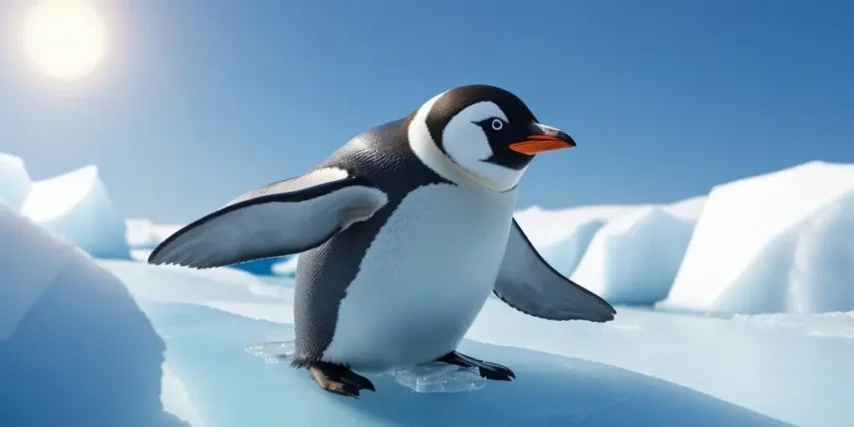Penguins at the Pole: Unraveling the Enigmatic Lives of Earth’s Tuxedoed Residents
The world of the polar regions, characterized by icy landscapes and frigid temperatures, is home to some of the most fascinating creatures on Earth. Among these resilient inhabitants are the endearing penguins, uniquely adapted to thrive in the harsh conditions near the poles. In this article, we embark on a journey to explore the reasons why penguins have chosen these extreme environments as their homes, unraveling the secrets behind their remarkable survival strategies.
Adaptations to Cold Environments:
Penguins are renowned for their distinctive appearance, clad in black and white feathers resembling a perfectly tailored tuxedo. This iconic look serves a crucial purpose in their survival within the polar climates. The black feathers on their backs absorb sunlight, helping them stay warm in freezing temperatures, while the white feathers on their bellies provide camouflage from predators lurking beneath the icy waters.

The poleward migration of penguins can be attributed to their remarkable physiological adaptations. Their wings, evolved into flippers, enable them to navigate through the water with remarkable agility. Underwater, penguins are transformed into skilled hunters, relying on their streamlined bodies and powerful flippers to chase down prey like fish and squid. This adaptation has proven essential for their survival in polar ecosystems, where the majority of their food sources thrive beneath the icy seas.
Optimal Breeding Conditions:
Another compelling reason for penguins’ presence at the poles is the optimal conditions these regions provide for breeding. While most species of penguins prefer more temperate climates for breeding, some, like the Emperor and Adélie penguins, have made the icy expanses of Antarctica their nesting grounds.
In Antarctica, penguins take advantage of the vast ice sheets to create colonies, where they can safely incubate their eggs and raise their chicks. The isolation of these colonies offers protection from land-based predators, and the abundance of food in the surrounding waters ensures a steady supply for both adults and their hungry offspring.

Interestingly, the extreme temperatures of the polar regions also play a role in penguin parenting. The harsh conditions act as a natural barrier, discouraging other animals from encroaching on their territories. This isolation provides penguins with a unique niche where they can raise their young without the intense competition for resources experienced in more temperate environments.
Specialized Feeding Opportunities:
Penguins’ choice to inhabit polar regions is closely tied to the availability of specialized feeding opportunities. The cold waters surrounding the poles are nutrient-rich, fostering the growth of phytoplankton and zooplankton—the primary sources of food for many marine species. These microscopic organisms attract a variety of fish, forming the foundation of the Antarctic food web.
Penguins, being expert hunters, take advantage of this abundance of marine life. They have evolved to dive to impressive depths, sometimes reaching over 500 meters, in pursuit of their prey. The cold waters serve as a natural pantry for penguins, offering a diverse menu of fish, krill, and squid. The ability to exploit these specialized feeding opportunities has made the polar regions ideal hunting grounds for penguins, influencing their choice of habitat.
Climate Change and the Future of Polar Penguins:
While penguins have successfully adapted to the challenges posed by polar environments over millions of years, the rapid changes brought about by climate change are now threatening their way of life. Rising temperatures, melting ice, and altered food availability are impacting penguin populations, pushing them to the brink of survival.

As global temperatures continue to rise, the delicate balance of polar ecosystems is disrupted, affecting the abundance and distribution of penguins’ prey. Additionally, the reduction of sea ice diminishes the available breeding and molting habitats for these remarkable birds. Consequently, some penguin species face the daunting challenge of adapting to a rapidly changing environment or facing the risk of decline.
In conclusion, the decision of penguins to live at the poles is a testament to their incredible adaptability and resilience. These charismatic birds have mastered the art of survival in some of the harshest environments on Earth, taking advantage of specialized adaptations, optimal breeding conditions, and unique feeding opportunities. However, as climate change continues to alter the polar landscapes, the future of penguins hangs in the balance, emphasizing the need for global conservation efforts to protect these extraordinary creatures and the delicate ecosystems they call home. The story of penguins at the pole is not only a tale of survival but also a poignant reminder of the interconnectedness of all life on our planet.







